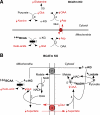Disruption of BCAA metabolism in mice impairs exercise metabolism and endurance
- PMID: 20133434
- PMCID: PMC2853195
- DOI: 10.1152/japplphysiol.01248.2009
Disruption of BCAA metabolism in mice impairs exercise metabolism and endurance
Abstract
Exercise enhances branched-chain amino acid (BCAA) catabolism, and BCAA supplementation influences exercise metabolism. However, it remains controversial whether BCAA supplementation improves exercise endurance, and unknown whether the exercise endurance effect of BCAA supplementation requires catabolism of these amino acids. Therefore, we examined exercise capacity and intermediary metabolism in skeletal muscle of knockout (KO) mice of mitochondrial branched-chain aminotransferase (BCATm), which catalyzes the first step of BCAA catabolism. We found that BCATm KO mice were exercise intolerant with markedly decreased endurance to exhaustion. Their plasma lactate and lactate-to-pyruvate ratio in skeletal muscle during exercise and lactate release from hindlimb perfused with high concentrations of insulin and glucose were significantly higher in KO than wild-type (WT) mice. Plasma and muscle ammonia concentrations were also markedly higher in KO than WT mice during a brief bout of exercise. BCATm KO mice exhibited 43-79% declines in the muscle concentration of alanine, glutamine, aspartate, and glutamate at rest and during exercise. In response to exercise, the increments in muscle malate and alpha-ketoglutarate were greater in KO than WT mice. While muscle ATP concentration tended to be lower, muscle IMP concentration was sevenfold higher in KO compared with WT mice after a brief bout of exercise, suggesting elevated ammonia in KO is derived from the purine nucleotide cycle. These data suggest that disruption of BCAA transamination causes impaired malate/aspartate shuttle, thereby resulting in decreased alanine and glutamine formation, as well as increases in lactate-to-pyruvate ratio and ammonia in skeletal muscle. Thus BCAA metabolism may regulate exercise capacity in mice.
Figures







References
-
- Aragon JJ, Lowenstein JM. The purine-nucleotide cycle. Comparison of the levels of citric acid cycle intermediates with the operation of the purine nucleotide cycle in rat skeletal muscle during exercise and recovery from exercise. Eur J Biochem 110: 371–377, 1980 - PubMed
-
- Babij P, Matthews SM, Rennie MJ. Changes in blood ammonia, lactate and amino acids in relation to workload during bicycle ergometer exercise in man. Eur J Appl Physiol Occup Physiol 50: 405–411, 1983 - PubMed
-
- Beckett PR. Spectrophotometric assay for measuring branched-chain amino acids. In: Methods in Enzymology Branched-chain amino acids, Part B, edited by Harris RA, Sokatch JR. New York: Academic, 2000, p. 40–47 - PubMed
-
- Block KP, Richmond WB, Mehard WB, Buse MG. Glucocorticoid-mediated activation of muscle branched-chain α-keto acid dehydrogenase in vivo. Am J Physiol Endocrinol Metab 252: E396–E407, 1987 - PubMed
-
- Blomstrand E, Ek S, Newsholme EA. Influence of ingesting a solution of branched-chain amino acids on plasma and muscle concentrations of amino acids during prolonged submaximal exercise. Nutrition 12: 485–490, 1996 - PubMed
Publication types
MeSH terms
Substances
Grants and funding
LinkOut - more resources
Full Text Sources
Molecular Biology Databases
Research Materials

